Umar Farooq Minhas
KG-TRICK: Unifying Textual and Relational Information Completion of Knowledge for Multilingual Knowledge Graphs
Jan 07, 2025



Abstract:Multilingual knowledge graphs (KGs) provide high-quality relational and textual information for various NLP applications, but they are often incomplete, especially in non-English languages. Previous research has shown that combining information from KGs in different languages aids either Knowledge Graph Completion (KGC), the task of predicting missing relations between entities, or Knowledge Graph Enhancement (KGE), the task of predicting missing textual information for entities. Although previous efforts have considered KGC and KGE as independent tasks, we hypothesize that they are interdependent and mutually beneficial. To this end, we introduce KG-TRICK, a novel sequence-to-sequence framework that unifies the tasks of textual and relational information completion for multilingual KGs. KG-TRICK demonstrates that: i) it is possible to unify the tasks of KGC and KGE into a single framework, and ii) combining textual information from multiple languages is beneficial to improve the completeness of a KG. As part of our contributions, we also introduce WikiKGE10++, the largest manually-curated benchmark for textual information completion of KGs, which features over 25,000 entities across 10 diverse languages.
Incremental IVF Index Maintenance for Streaming Vector Search
Nov 01, 2024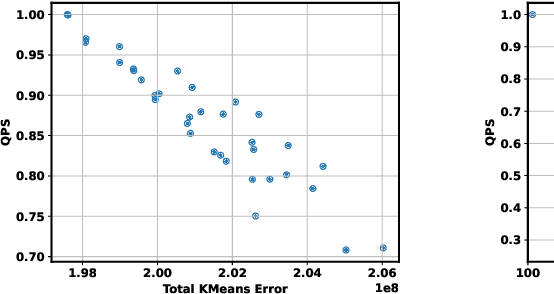
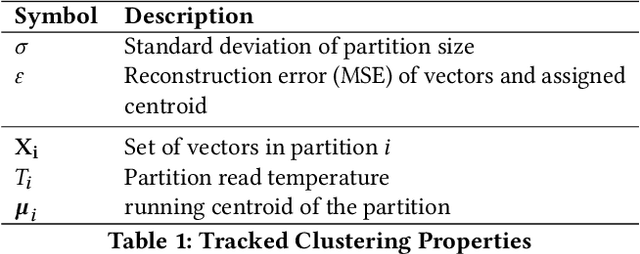
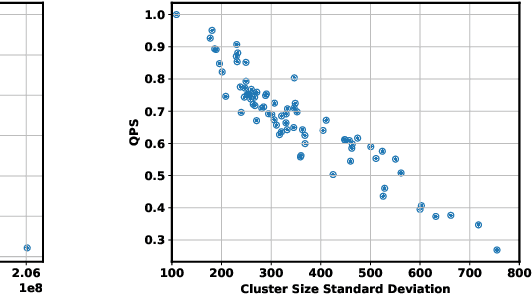

Abstract:The prevalence of vector similarity search in modern machine learning applications and the continuously changing nature of data processed by these applications necessitate efficient and effective index maintenance techniques for vector search indexes. Designed primarily for static workloads, existing vector search indexes degrade in search quality and performance as the underlying data is updated unless costly index reconstruction is performed. To address this, we introduce Ada-IVF, an incremental indexing methodology for Inverted File (IVF) indexes. Ada-IVF consists of 1) an adaptive maintenance policy that decides which index partitions are problematic for performance and should be repartitioned and 2) a local re-clustering mechanism that determines how to repartition them. Compared with state-of-the-art dynamic IVF index maintenance strategies, Ada-IVF achieves an average of 2x and up to 5x higher update throughput across a range of benchmark workloads.
Towards Cross-Cultural Machine Translation with Retrieval-Augmented Generation from Multilingual Knowledge Graphs
Oct 17, 2024



Abstract:Translating text that contains entity names is a challenging task, as cultural-related references can vary significantly across languages. These variations may also be caused by transcreation, an adaptation process that entails more than transliteration and word-for-word translation. In this paper, we address the problem of cross-cultural translation on two fronts: (i) we introduce XC-Translate, the first large-scale, manually-created benchmark for machine translation that focuses on text that contains potentially culturally-nuanced entity names, and (ii) we propose KG-MT, a novel end-to-end method to integrate information from a multilingual knowledge graph into a neural machine translation model by leveraging a dense retrieval mechanism. Our experiments and analyses show that current machine translation systems and large language models still struggle to translate texts containing entity names, whereas KG-MT outperforms state-of-the-art approaches by a large margin, obtaining a 129% and 62% relative improvement compared to NLLB-200 and GPT-4, respectively.
Entity Disambiguation via Fusion Entity Decoding
Apr 02, 2024

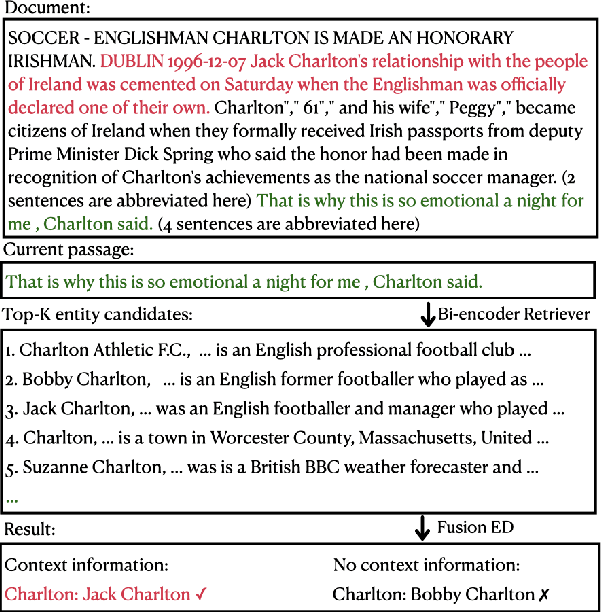

Abstract:Entity disambiguation (ED), which links the mentions of ambiguous entities to their referent entities in a knowledge base, serves as a core component in entity linking (EL). Existing generative approaches demonstrate improved accuracy compared to classification approaches under the standardized ZELDA benchmark. Nevertheless, generative approaches suffer from the need for large-scale pre-training and inefficient generation. Most importantly, entity descriptions, which could contain crucial information to distinguish similar entities from each other, are often overlooked. We propose an encoder-decoder model to disambiguate entities with more detailed entity descriptions. Given text and candidate entities, the encoder learns interactions between the text and each candidate entity, producing representations for each entity candidate. The decoder then fuses the representations of entity candidates together and selects the correct entity. Our experiments, conducted on various entity disambiguation benchmarks, demonstrate the strong and robust performance of this model, particularly +1.5% in the ZELDA benchmark compared with GENRE. Furthermore, we integrate this approach into the retrieval/reader framework and observe +1.5% improvements in end-to-end entity linking in the GERBIL benchmark compared with EntQA.
Increasing Coverage and Precision of Textual Information in Multilingual Knowledge Graphs
Nov 27, 2023



Abstract:Recent work in Natural Language Processing and Computer Vision has been using textual information -- e.g., entity names and descriptions -- available in knowledge graphs to ground neural models to high-quality structured data. However, when it comes to non-English languages, the quantity and quality of textual information are comparatively scarce. To address this issue, we introduce the novel task of automatic Knowledge Graph Enhancement (KGE) and perform a thorough investigation on bridging the gap in both the quantity and quality of textual information between English and non-English languages. More specifically, we: i) bring to light the problem of increasing multilingual coverage and precision of entity names and descriptions in Wikidata; ii) demonstrate that state-of-the-art methods, namely, Machine Translation (MT), Web Search (WS), and Large Language Models (LLMs), struggle with this task; iii) present M-NTA, a novel unsupervised approach that combines MT, WS, and LLMs to generate high-quality textual information; and, iv) study the impact of increasing multilingual coverage and precision of non-English textual information in Entity Linking, Knowledge Graph Completion, and Question Answering. As part of our effort towards better multilingual knowledge graphs, we also introduce WikiKGE-10, the first human-curated benchmark to evaluate KGE approaches in 10 languages across 7 language families.
Growing and Serving Large Open-domain Knowledge Graphs
May 16, 2023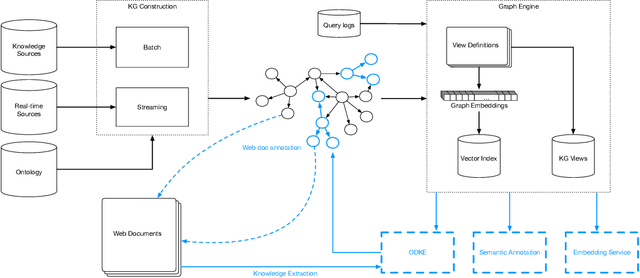
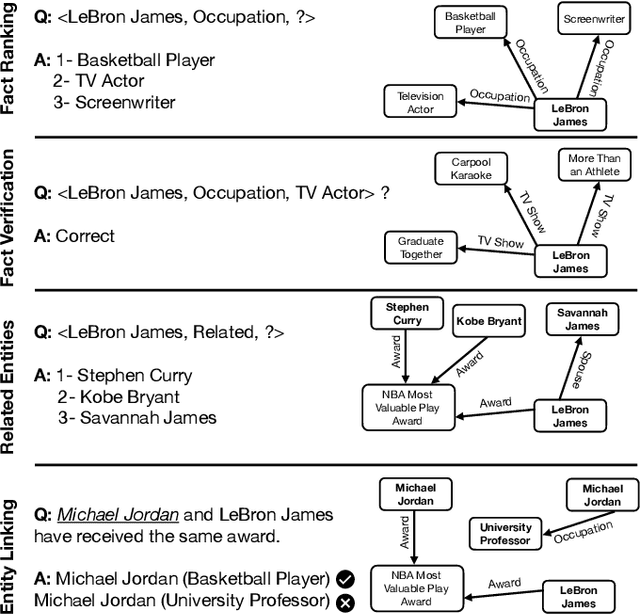
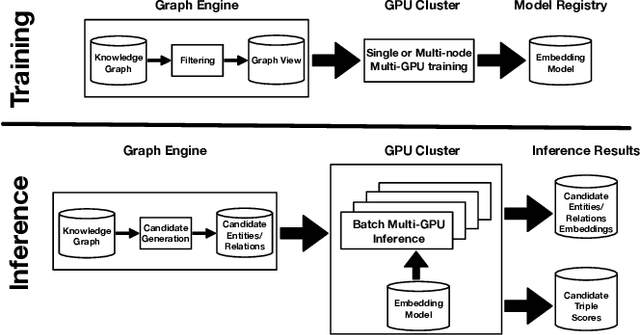
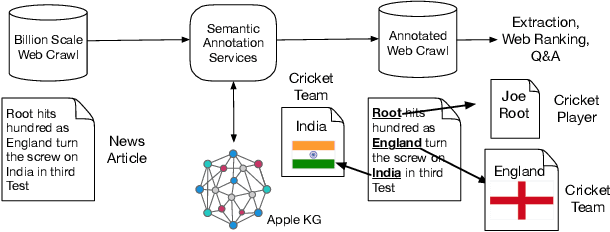
Abstract:Applications of large open-domain knowledge graphs (KGs) to real-world problems pose many unique challenges. In this paper, we present extensions to Saga our platform for continuous construction and serving of knowledge at scale. In particular, we describe a pipeline for training knowledge graph embeddings that powers key capabilities such as fact ranking, fact verification, a related entities service, and support for entity linking. We then describe how our platform, including graph embeddings, can be leveraged to create a Semantic Annotation service that links unstructured Web documents to entities in our KG. Semantic annotation of the Web effectively expands our knowledge graph with edges to open-domain Web content which can be used in various search and ranking problems. Finally, we leverage annotated Web documents to drive Open-domain Knowledge Extraction. This targeted extraction framework identifies important coverage issues in the KG, then finds relevant data sources for target entities on the Web and extracts missing information to enrich the KG. Finally, we describe adaptations to our knowledge platform needed to construct and serve private personal knowledge on-device. This includes private incremental KG construction, cross-device knowledge sync, and global knowledge enrichment.
High-Throughput Vector Similarity Search in Knowledge Graphs
Apr 04, 2023



Abstract:There is an increasing adoption of machine learning for encoding data into vectors to serve online recommendation and search use cases. As a result, recent data management systems propose augmenting query processing with online vector similarity search. In this work, we explore vector similarity search in the context of Knowledge Graphs (KGs). Motivated by the tasks of finding related KG queries and entities for past KG query workloads, we focus on hybrid vector similarity search (hybrid queries for short) where part of the query corresponds to vector similarity search and part of the query corresponds to predicates over relational attributes associated with the underlying data vectors. For example, given past KG queries for a song entity, we want to construct new queries for new song entities whose vector representations are close to the vector representation of the entity in the past KG query. But entities in a KG also have non-vector attributes such as a song associated with an artist, a genre, and a release date. Therefore, suggested entities must also satisfy query predicates over non-vector attributes beyond a vector-based similarity predicate. While these tasks are central to KGs, our contributions are generally applicable to hybrid queries. In contrast to prior works that optimize online queries, we focus on enabling efficient batch processing of past hybrid query workloads. We present our system, HQI, for high-throughput batch processing of hybrid queries. We introduce a workload-aware vector data partitioning scheme to tailor the vector index layout to the given workload and describe a multi-query optimization technique to reduce the overhead of vector similarity computations. We evaluate our methods on industrial workloads and demonstrate that HQI yields a 31x improvement in throughput for finding related KG queries compared to existing hybrid query processing approaches.
Bounding the Last Mile: Efficient Learned String Indexing
Nov 29, 2021

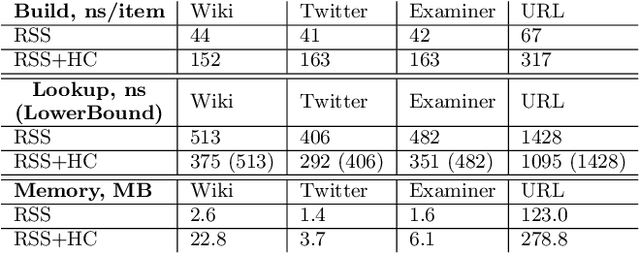
Abstract:We introduce the RadixStringSpline (RSS) learned index structure for efficiently indexing strings. RSS is a tree of radix splines each indexing a fixed number of bytes. RSS approaches or exceeds the performance of traditional string indexes while using 7-70$\times$ less memory. RSS achieves this by using the minimal string prefix to sufficiently distinguish the data unlike most learned approaches which index the entire string. Additionally, the bounded-error nature of RSS accelerates the last mile search and also enables a memory-efficient hash-table lookup accelerator. We benchmark RSS on several real-world string datasets against ART and HOT. Our experiments suggest this line of research may be promising for future memory-intensive database applications.
Qd-tree: Learning Data Layouts for Big Data Analytics
Apr 22, 2020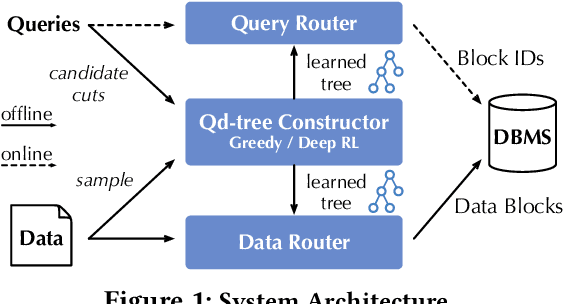
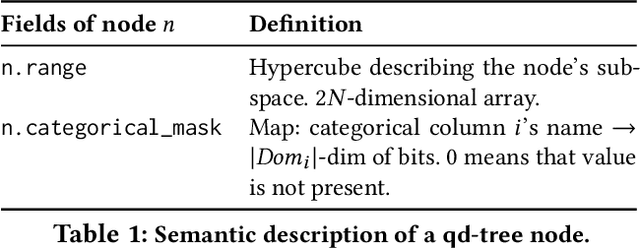
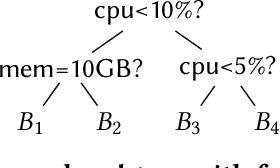

Abstract:Corporations today collect data at an unprecedented and accelerating scale, making the need to run queries on large datasets increasingly important. Technologies such as columnar block-based data organization and compression have become standard practice in most commercial database systems. However, the problem of best assigning records to data blocks on storage is still open. For example, today's systems usually partition data by arrival time into row groups, or range/hash partition the data based on selected fields. For a given workload, however, such techniques are unable to optimize for the important metric of the number of blocks accessed by a query. This metric directly relates to the I/O cost, and therefore performance, of most analytical queries. Further, they are unable to exploit additional available storage to drive this metric down further. In this paper, we propose a new framework called a query-data routing tree, or qd-tree, to address this problem, and propose two algorithms for their construction based on greedy and deep reinforcement learning techniques. Experiments over benchmark and real workloads show that a qd-tree can provide physical speedups of more than an order of magnitude compared to current blocking schemes, and can reach within 2X of the lower bound for data skipping based on selectivity, while providing complete semantic descriptions of created blocks.
ALEX: An Updatable Adaptive Learned Index
May 21, 2019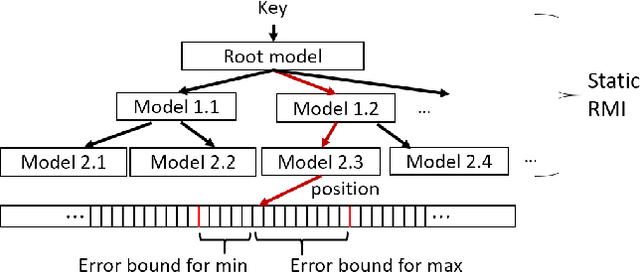
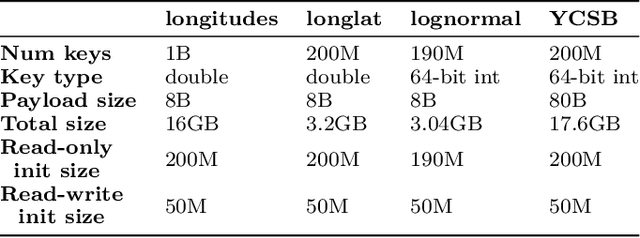
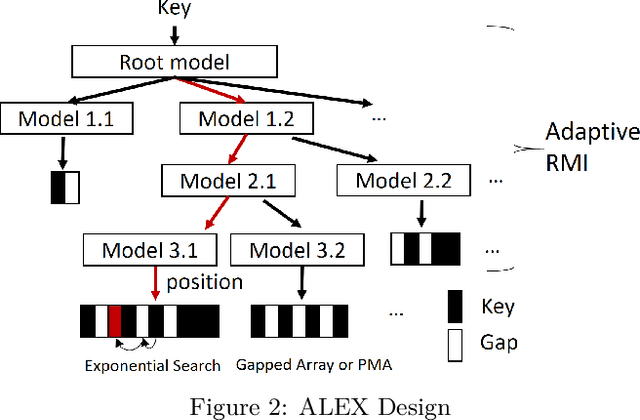

Abstract:Recent work on "learned indexes" has revolutionized the way we look at the decades-old field of DBMS indexing. The key idea is that indexes are "models" that predict the position of a key in a dataset. Indexes can, thus, be learned. The original work by Kraska et al. shows surprising results in terms of search performance and space requirements: A learned index beats a B+Tree by a factor of up to three in search time and by an order of magnitude in memory footprint, however it is limited to static, read-only workloads. This paper presents a new class of learned indexes called ALEX which addresses issues that arise when implementing dynamic, updatable learned indexes. Compared to the learned index from Kraska et al., ALEX has up to 3000X lower space requirements, but has up to 2.7X higher search performance on static workloads. Compared to a B+Tree, ALEX achieves up to 3.5X and 3.3X higher performance on static and some dynamic workloads, respectively, with up to 5 orders of magnitude smaller index size. Our detailed experiments show that ALEX presents a key step towards making learned indexes practical for a broader class of database workloads with dynamic updates.
 Add to Chrome
Add to Chrome Add to Firefox
Add to Firefox Add to Edge
Add to Edge